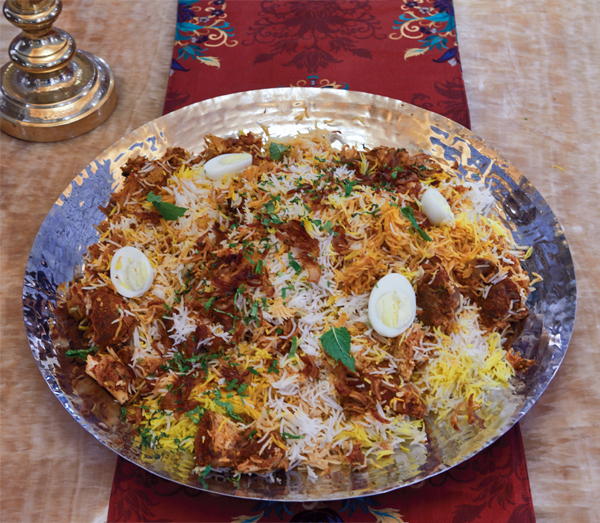

HOW A BIRYANI CHANGED A LIFE
When Anisha and Nihal were little and we were still finding our feet in Delhi, my days were always packed. Between looking after the children, hosting people and running the house, I needed all the help I could get. At the same time, I was a consultant for Lepakshi, the Andhra emporium in Delhi, and I designed Indian and western outfits for them. It was especially challenging to keep Nihal busy and I was always trying to find a solution.
As it happened, a young boy from Tamil Nadu was brought to our house and we were told that he needed both a job and a place to stay. His name was Velu and he quickly became a part of our home, and then our family. I initially gave him only one job – to play with Nihal, but he was eager to help in any way he could, so he began working with me in the kitchen. Velu was an eager student who was quick to learn the recipes we cooked. Little did any of us know how it would change his life.
I am going to let Velu, who now lives in Washington DC, tell his own story, as he has written it:
My parents passed away when I was very young and I moved from my village in Tamil Nadu to New Delhi, in search of a job. When I first arrived, every day was a struggle and I did not even know how to speak Hindi. A friend found me a job with a Punjabi family but we could not communicate, so I quit in two days. My second job was at a restaurant in Munirka called Madras Restaurant. It was a lot of work for very little money and I realized that they were treating me unfairly because they knew I was desperate for a job. I spoke broken Hindi by then and had to stay on in a bad job because I could not find another. That first winter, I did not even own a sweater and was miserable. I finally asked a close friend, Shanmuganathan, if he could find another job for me. I would do any kind of work, I said, and he took me to the Hassans’ home.
We waited outside to see Ayya [Peter] and when he came home from work, Shanmuganathan asked if he would give me a job. The first thing Ayya said to me was, ‘Have you eaten anything? Eat first, then we will talk.’ At that moment, I felt like I was in heaven. I ate dinner and then Ayya asked my friend to translate the three rules of his house: ‘No lying. No stealing. No alcohol.’ He said that if I followed these rules, I could work in his house and he would make me a successful man. I started work that same day.
I learnt Hindi from Anisha and Nihal, and slowly started to help Amma [Doreen] in the kitchen. She first taught me how to make Dum Biryani, Pasanda Kabab and Tomato Chutney, and slowly I learnt all the other dishes that she used to make for parties. After about two-and-a-half years, one evening when Amma was in Hyderabad, Ayya asked me if I could cook dinner for his guests on my own. There were many VIP guests expected, including K.R. Narayanan, who later became the president of India. I said yes. When the party ended, Ayya told me that everyone had liked the food very much and that Mr Narayanan wanted to talk to me. He asked me if I would go to the USA with him, because he was being posted as India’s ambassador there. He offered to take me along as a cook. When I first heard him say that, I was very scared and said no. I did not want to leave my home and go to a foreign country.
Ayya said to me, ‘This is the best chance for a better life. Don’t miss it. I will tell him to leave you in America to find another job when he finishes his term. Don’t be scared to go with the ambassador. He’s a nice man and he will take care of you. If there are any problems, I will send you a plane ticket and you can come back to India.’
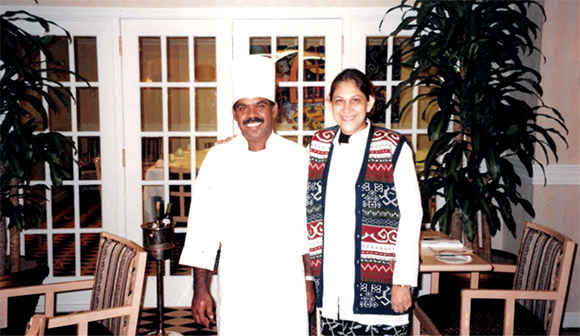
I took his advice and worked for Ambassador Narayanan for three years in Washington. When he returned to India, I stayed in the US and found a job at Taj Mahal Restaurant in DC. The owner sponsored me so I could get my green card. In the meantime, I married my wife Shantha, who was from New Jersey. She is a wonderful wife and life partner. Our daughter Gowry was born soon after and I needed more income to buy a house. After working at the Indian restaurant for eight years, I quit, learnt how to cook American food and became a sous chef at the Embassy Row Hilton Hotel in DC. By then, our son Sekar was also born. At this time, the Hassan family visited me, which made me really happy. I worked at the hotel for eight years as well, but I needed more flexible hours since Shantha didn’t know how to drive and my children needed someone to take them to and from school activities. I decided to drive a taxi, which I still do.
I have been able to give my children a good education and am so proud of them. They both went to college at University of Maryland. Gowry studied Early Childhood Development at Swansea University in Wales, UK, and is now a graduate of medical school, with plans to start her Paediatric Residency. Sekar earned his undergraduate degree with honours and spent his summers interning at Johns Hopkins, Northrop Grummond, and MIT. He is going to graduate school at Carnegie Mellon University in Pittsburgh for a PhD in Computer Engineering.
My life has been very successful since I met Ayya and Amma, and everything good that has happened to me has been their gift to me. I still think of Anisha and Nihal as little children, and it makes me very happy to see them as parents now. My family and I will never forget the Hassans and I always tell my children how important they are to me. Without them, I don’t know where I would have been.
We have visited Velu several times in Washington and met his family, and he remains very special to us. He and his family are all American citizens now, due to Velu’s hard work and belief that he will succeed where others may have failed. His success is testament to his courage and enterprise – he took a chance and made the best of it.
TAHARI
Tahari is cooked by several communities across the country. This is the Hyderabadi version, which is lightly spiced and a meal in itself.
INGREDIENTS
1 kg Basmati rice
½ kg potatoes
10 cups water
8 medium-sized onions, finely sliced
8 green chillies
8 cardamoms
5 cloves
1 2" cinnamon stick
4 tablespoons oil
2 teaspoons turmeric powder
Salt to taste
METHOD
Soak the rice for about 30 minutes in cold water. Drain and set aside. Boil the ten cups of water to cook the rice in – cover, and set aside too.
Cube potatoes and soak in a dish of salted water.
Heat oil in a pan large enough to cook the rice in. Fry the sliced onions until golden brown. Remove onto a plate lined with absorbent paper, and set aside.
Add ginger-garlic paste to the same oil and sauté until fragrant. To this, add cinnamon, cloves, cardamoms, turmeric powder and potatoes. Continue cooking for about 3-4 minutes.
Bring the pan of warm water back to a boil at this point.
Add drained rice to the aromatics and mix well; lower the flame and let everything in the pan amalgamate for 3-4 minutes. Pour in the boiling water and stir only once. Cover and cook on a low flame until the rice is done.
Serve on a flat platter, garnished with fried onions and finely chopped coriander leaves.

CHANE KI KHUBOOLI
The flavours of this vegetarian dish are very similar to the Kachchi Biryani.
INGREDIENTS
1 kg Basmati rice
¼ kg Bengal gram
¼ kg yogurt
¼ kg oil
10 cups water
1 glass milk
5 large onions
4 green chillies, finely chopped
2 limes
A small bunch of coriander leaves, finely chopped
A small bunch of mint leaves, finely chopped
5 cloves
5 cardamoms
1 2" stick cinnamon
2 tablespoons ghee
2 tablespoons ginger-garlic paste
2 teaspoons red chilli powder
1 teaspoon turmeric powder
½ teaspoon saffron strands
METHOD
Wash and cook the lentils until tender but firm.
Wash rice well and soak in cold water for 30 minutes. Drain and set aside.
Heat oil and fry onions until golden brown in a pan large enough to cook the lentils. Remove onto a plate lined with absorbent paper, and set aside.
Add ginger-garlic paste to the same oil that you fried onions in, and let cook until fragrant. Then, add chilli powder and turmeric powder and sauté for a while to let the flavours amalgamate. Add the yogurt and sauté well. Now, add in the cooked lentils, chopped coriander leaves, green chillies, mint leaves and lime juice. Cook until the yogurt blends with the lentils.
Put ten cups of water to the boil. When it comes to a rolling boil, add in the drained rice and cook until three-fourths done.
Grease a large heavy-bottomed pan with a tablespoon of ghee and spoon a layer of rice over the bottom. Spoon the lentil mixture over the rice. Then, sprinkle some fried onions, chopped coriander and mint leaves, two green chillies and cover with more rice.
Repeat until you have used all the rice and lentils, and finally pour two tablespoons of ghee over the top.
Melt saffron in half a glass of milk and sprinkle over the rice. Sprinkle the other half-glass of plain milk too.
Seal the pan and cook on a high flame for 15 minutes and then on a low flame for 20 minutes.
Serve garnished with fried onions and cut coriander and mint leaves.
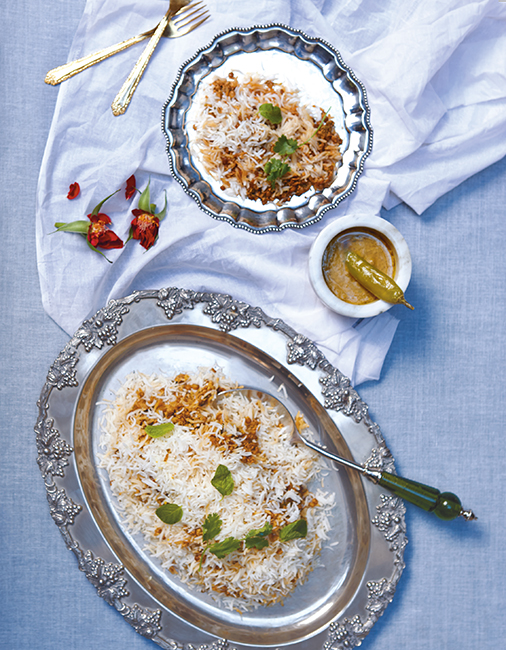
SAFED PULAO
This is a dish that looks lovely and is full of unusual flavours. It is the centrepiece of my White Menu (Page 208). Serve it on a silver platter, if you can, to showcase its delicate beauty.
INGREDIENTS
1 kg Basmati rice
1 kg mutton – adla cut, chops, marrow bones
½ kg yogurt
¼ kg onions
¼ kg oil
½ litre milk
100 gm fresh cream
10 cups water
1 small bunch coriander leaves
1 small bunch mint leaves
6 green chillies
6 cardamoms
3 bay leaves
2 1" cinnamon sticks
3 tablespoons ghee
4 teaspoons ginger-garlic paste
1 teaspoon black cumin seeds
Salt to taste
METHOD
Wash rice and soak for 30 minutes in cold water.
Wash meat and marinate for 30 minutes with ginger-garlic paste.
Grind the coriander and mint leaves into a paste.
Add this paste, yogurt, fresh cream and salt to taste to the meat. In a pan large enough to cook the pulao in, put water to the boil with cardamoms, cinnamon sticks, black cumin seeds and bay leaves.
When it comes to a rolling boil, add the rice and cook till it is three-fourths done.
Drain through a strainer and spread out on a large flat plate.
Heat oil in a pan, large enough to cook the meat in, and fry onions until golden brown. Add the marinated meat and green chillies. Pour in two to three cups of water to form a thick gravy and cook until the meat is tender. Take the pan off the stove when the meat is cooked.
Layer the partly-cooked rice over the meat. Sprinkle milk over the rice and dot with three tablespoons of ghee.
Seal the pan and cook over high flame for 10 minutes and on a low flame for about 20 minutes, until the rice is done.
Serve garnished with fried onions.
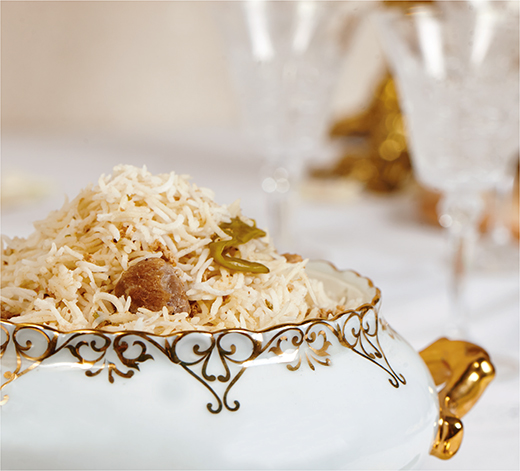
CHILLAV
INGREDIENTS
1 kg Basmati rice
1 kg minced meat
¼ kg yogurt
¼ kg coriander leaves
¼ kg onions, finely sliced
10 cups water
½ cup oil
6 green chillies
Juice of 2 limes
2 tablespoons ginger-garlic paste
2 teaspoons red chilli powder
1 teaspoon turmeric powder
METHOD
Soak the rice for about half an hour in cold water. Drain and set aside. Boil the water to cook the rice in – cover, and set aside too.
In a pan large enough to cook the rice in, heat oil and fry sliced onions until golden brown. Add ginger-garlic paste and chilli and turmeric powders; cook until fragrant.
Mix in the yogurt and stir to combine for a few minutes. Then, add the minced meat. Cook until the raw smell of the meat disappears. The mince must also blend well with the yogurt.
In the meantime, put the pan of water back to the boil.
Add to the pan of meat, rice and mix well. When the mixture begins to brown, pour in the boiling water and stir well. Cover and cook on a low flame.
Add chopped coriander leaves, green chillies and lime juice when there is very little liquid in the pan. Cook until there is no liquid in the pan.
Serve garnished with chopped coriander leaves.
NIMBU ZAFRANI PULAO
INGREDIENTS
1 kg Basmati rice
10 cups chicken stock, made with the bones of 1 chicken
1 cup coriander leaves, finely chopped
¾ cup lemon juice
4 medium-sized onions
1 sprig curry leaves
3 tablespoons oil
2 tablespoons ghee
2 tablespoons lemon rind, grated
3 teaspoons ginger-garlic paste
1 teaspoon saffron strands
Salt to taste
METHOD
Prepare chicken stock by pressure cooking the chicken bones in about eleven cups of water.
Melt the saffron and mix it with the stock. Set aside.
Heat oil and ghee in a pan, large enough to cook the rice in.
Add onions, ginger-garlic paste and curry leaves. Lower the flame and let the onions turn golden brown. Then add rice and lemon rind.
Mix well, and let cook for a few minutes before pouring in the chicken stock. Cover and cook until the liquid is nearly drying up. At that point, put in the lemon juice and coriander leaves.
Simmer for another 5-7 minutes until the rice is cooked and there is no liquid in the pan.
Serve garnished with finely chopped coriander leaves.
KACHCHI BIRYANI
After my children and I returned home to Delhi from that early trip to Hyderabad, and my cooking lesson from Phuppu Jani, Peter began calling people over for dinner often. One evening, I decided to make the mutton biryani that I had learnt. To make it less stressful for myself, I didn’t tell Peter of my plan. I made it when he was at work. Because I had been watching the cooks – first the lady, and now the man Peter had found – at home in Delhi more closely, I knew my way around the kitchen by now. When Peter came home, I told him that I had ordered it in. He had many questions about where it was from but I managed to evade all of them. I served the biryani and our guests seemed to like it. At the end of the evening, I told Peter I had made it and he said – ‘Don’t tell me! I don’t believe it. It was very good, very, very good.’ Peter was always so encouraging, which motivated me to try my hand at more dishes and slowly, I discovered a real love for cooking, which holds true till this day.
INGREDIENTS
1 kg Basmati rice
1 kg adla mutton (meat from the shin bone)
½ kg oil
½ kg onions, finely sliced
¼ kg milk
¼ kg yogurt
3 bunches coriander leaves, finely chopped
2 bunches mint leaves, finely chopped
10 green chillies, slit
3 limes
5 cardamoms
3 1" cinnamon sticks
3 bay leaves
2 tablespoons ginger-garlic paste
3 teaspoons green papaya paste
2 teaspoons black cumin seeds
1 teaspoon saffron strands
Salt to taste
Grind to a fine powder
12 cardamoms
6 cloves
6 1" sticks cinnamon
METHOD
Fry the onions until golden brown. Remove onto a plate lined with absorbent paper, and let cool. Then, mash into a crumbly powder and keep aside.
Pour the oil out of the pan, sieve and set aside too.
Rub the meat with a halved onion as you wash it. Drain off any juices that are released. In the pan in which you are going to cook the meat, marinate it with the papaya paste for about 2 hours. Drain off any more juices that collect in the pan. Now, smear the ginger-garlic paste and two tablespoons of salt on the meat. Set aside for another hour. Add yogurt to the marinated meat and leave for another half hour.
Finally, mix in the masala you ground up along with the chopped coriander and mint leaves, fried onions and green chillies with the meat. Pour the oil you had set aside into the pan.
Heat water with cardamoms, cinnamon sticks, black cumin seeds and bay leaves in a separate large pan. When it comes to a rolling boil, add in the rice and cook until half done. Drain the rice but leave some water in there – do not let it dry out completely.
Layer the parboiled rice over the marinated meat.
Dissolve the saffron in the milk and sprinkle this mixture over the rice and meat. Dot with about four tablespoons of ghee or oil.
Seal the pan with dough and place it on a high flame for about fifteen minutes. Then lower the flame and cook for another 30 minutes.
Before you serve, use a very large spatula or a small plate to cut through the biryani from the top to the bottom but do not disturb the layering. It does not need to be mixed.
Garnish with fried onions, coriander and mint leaves.
PUKKI BIRYANI
INGREDIENTS
1 kg Basmati rice
1 kg adla mutton (meat from the shin bone)
½ kg yogurt
¼ kg oil
1 glass milk
½ cup ginger-garlic paste
4 bunches coriander leaves
2 bunches mint leaves
8 green chillies
2 large onions, finely sliced
3 limes
10-12 cardamoms
4 cloves
1 2" cinnamon stick
2 teaspoons black cumin seeds
2 teaspoons chilli powder
1 teaspoon turmeric powder
1 teaspoon saffron strands
Salt to taste
METHOD
When you buy the meat, get it cut into medium-sized pieces. Wash the rice and soak for at least 30 minutes in cold water.
Mix meat with ginger-garlic paste, turmeric powder, two teaspoons of salt and yogurt. Set aside for at least an hour. You can leave it to marinate for 2-3 hours or overnight.
Heat oil in a large pan and fry onions until golden brown. Remove onto a plate lined with absorbent paper, and set aside. To the same oil, add six cardamoms and a teaspoon of black cumin seeds. When these splutter, add the meat and cook until a thick gravy forms. This takes about 30-45 minutes.
Add two teaspoons of chilli powder just as the meat is nearly done, and leave the pan on the stove until the oil rises to the surface. Put 10-12 cups water to the boil, with cloves, cinnamon sticks, six cardamoms and a teaspoon of black cumin seeds. Once it comes to a rolling boil, add the drained rice to it and cook until three-fourths done.
Pass the cooked rice through a strainer, making sure you retain the whole spices and about half a glass of water. Do not dry out the rice completely. Grease a pan and layer half the rice on the bottom. Then spread a layer of meat. Sprinkle half the fried onions, half of the chopped coriander and mint leaves, green chillies and the juice of three limes. Repeat all three layers.
Cover with the remaining rice and pour over the oil that you drained off the meat curry.
Mix saffron in milk and sprinkle over the rice. Seal the pan and cook on dhum for 15 minutes.
Before you serve, use a very large spatula or a small plate to cut through the biryani from the top to the bottom. This makes it easier for everyone to serve themselves. Garnish with the remaining fried onions and coriander and mint leaves.
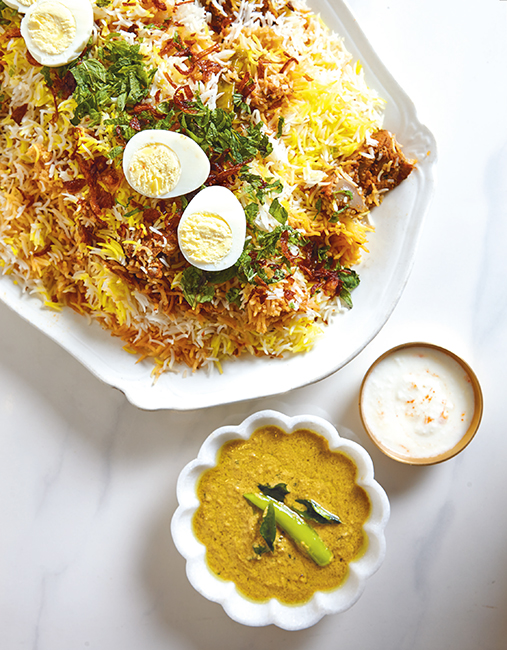
HYDERABADI MUTTON PULAO
INGREDIENTS
1 kg adla meat (meat from the shin bone)
1 kg Basmati rice
¼ kg oil
10 cups water
1 cup milk
½ cup yogurt
1 bunch coriander leaves, finely chopped
1 bunch mint leaves, finely chopped
1 large onion, finely sliced
1 lime, juiced
6-8 green chillies, slit lengthwise
10 peppercorns
6 cloves
3 green cardamoms
3 1" cinnamon sticks
1 black cardamom
3 tablespoons fresh cream
1 heaped tablespoon coriander powder
2 teaspoons black cumin seeds
2 teaspoons ginger paste
1 teaspoon garlic paste
1 teaspoon saffron strands
Salt to taste
Roast lightly and grind
2 teaspoons poppy seeds
1 teaspoon chironjee
For the marinade
½ cup yogurt
1 heaped tablespoon dhaniya powder
2 teaspoons ginger paste
2 teaspoons poppy seeds
1 teaspoon garlic paste
1 teaspoon charoli
METHOD
TO PREPARE THE MUTTON
Mix the roasted and ground khus khus with the marinade ingredients and three cinnamon sticks, ten peppercorns and the black cardamom. Apply this marinade to the meat and leave for at least an hour. Place the mutton in a pan on a slow flame and cook until the meat softens. At that point, take the pan off the flame. If any oil has risen to the surface, drain it off and set it aside.
TO COOK THE RICE
Boil water with three cinnamon sticks, three cardamoms, six cloves, a heaped teaspoon black cumin seeds and salt to taste. When the water comes to a rolling boil, add rice and cook until three-fourths done.
In a large greased dish, layer half the rice. Top it with the cooked mutton. Sprinkle with the remaining black cumin seeds, lime juice, four green chillies and some of the coriander and mint leaves. Cover with the remaining rice. Mix salt in two cups of water and sprinkle over.
Mix the saffron in one cup of milk. Sprinkle this, and the oil you drained off the mutton, over the rice. Seal the pan and keep on a low flame for 15 minutes.
Serve garnished with fried onions, coriander leaves and whole mint leaves.
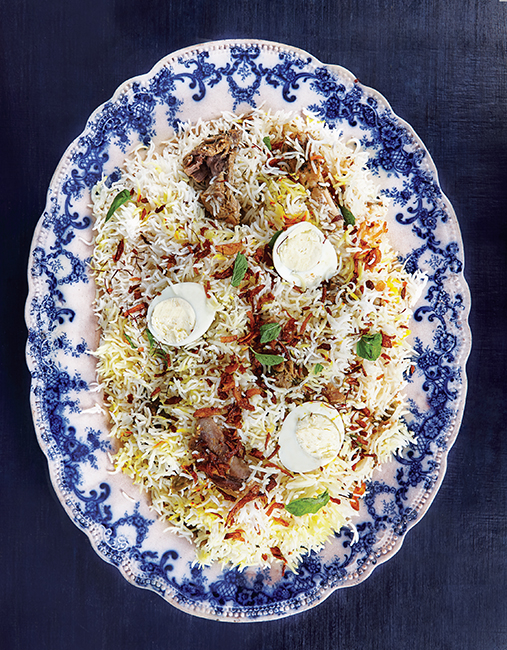
KAJU PULAO
INGREDIENTS
1 kg Basmati rice
250 gm onions, finely sliced
250 gm yogurt
200 gm cashew nuts
10 cups water
1 glass milk
1 bunch coriander leaves, finely chopped
1 bunch mint leaves, finely chopped
6 green chillies, slit
2 limes
4 cardamoms
2 1" cinnamon sticks
4 tablespoons ghee or oil
2 teaspoons chilli powder
2 teaspoons ginger-garlic paste
1 teaspoon turmeric powder
1 teaspoon saffron strands
½ teaspoon garam masala powder
½ teaspoon black cumin seeds
Salt to taste
METHOD
Heat oil in a frying pan and fry onions until light brown in colour. Remove onto a plate lined with absorbent paper, and set aside. In the same oil, lightly fry the cashew nuts; remove those onto a separate plate lined with absorbent paper.
Pour off the oil, sieve it and set it aside.
Mix the fried cashews with yogurt, half the fried onions, chilli powder, ginger-garlic paste, turmeric, salt and garam masala powder in a bowl.
Put water to boil in a pan large enough to cook the rice in. When it comes to a rolling boil, add rice, cardamom, cinnamon, black cumin seeds, half the coriander and mint leaves, three green chillies and salt.
Cook until the rice is three-fourths done. In the meantime, mix the saffron into the milk.
Take the pan off the heat and decant the rice to a plate or platter.
In the same pan, layer half the rice on the bottom. Then, pour over the yogurt-cashew mixture. Add the remaining coriander and mint leaves, three green chillies and some of the fried onions. Pour over the oil that you kept aside earlier.
Cover with the remaining rice and sprinkle the saffron-infused milk over the top. Dab with about four tablespoons of ghee or oil. Seal the pan and keep on dhum for about 20 minutes.
Serve garnished with fried onions and, if you like, chopped coriander and mint leaves.
NAWABI PULAO
INGREDIENTS
1 kg adla mutton (from the shin bone)
750 gm Basmati rice
10 cups water
1 cup yogurt, beaten
½ cup milk
5-6 medium-sized onions
10 peppercorns
10 apricots
6 red chillies
6 cardamoms
2 1" cinnamon sticks
1 tablespoon ginger-garlic paste
2 teaspoons garam masala powder
1 teaspoon black cumin seeds
1 teaspoon saffron strands
1 teaspoon turmeric powder
A handful each of almonds, cashew nuts, chironjee and raisins
Ghee
Salt to taste
METHOD
Wash the rice and set aside to soak in cold water for 30 minutes. Wash the mutton and set aside.
Fry onions until golden brown. Remove onto a plate lined with absorbent paper and let cool. Grind the fried onions and red chillies to a fine paste. Mix this paste with the beaten yogurt, ginger-garlic paste, turmeric and salt to taste. Marinate the mutton in the mixture for 90 minutes.
Heat five tablespoons of ghee in a frying pan and roast almonds, cashew nuts, chironjee and raisins. At the end of 90 minutes, heat 2 ½ tablespoons of oil or ghee in a pressure cooker. Add in the marinated mutton and cook until it softens.
Drain the soaked rice through a strainer and set aside. Put water to the boil. Dissolve saffron in milk. In a separate, large pan, heat a little ghee or oil, and add peppercorns, cinnamon sticks, cardamoms and black cumin seeds. When these splutter, add the drained rice and sauté for a while.
Pour in the boiling water and salt to taste. Cook until the rice is done. Spread the cooked rice on a plate or platter; pick out the spices and discard.
Take another pan large enough to cook the rice and mutton in, and grease the bottom and sides with ghee. Pour in the prepared mutton and sprinkle garam masala powder over it. Cover with the rice and dot with two tablespoons of ghee.
Make four deep holes in the layers and sprinkle the saffron-infused milk through these. Sprinkle the fried nuts and fried onions over the rice.
Seal the pan and cook on a low flame for 20 minutes.
Serve on a platter, garnished with chopped coriander and mint leaves.